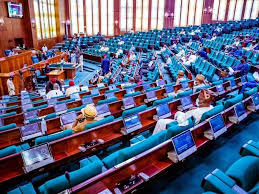By Oladosu Adebola Oluwaseun
The House of Representatives Committee on National Planning and Economic Development has called on the Central Bank of Nigeria (CBN) to carefully consider the potential negative consequences of its high-interest rate policy, which is currently the primary tool for combating inflation.This caution was delivered on Wednesday in Abuja by the Committee Chairman, Representative Gboyega Nasiru (APC-Ogun), during a crucial engagement with Mr. Adeyemi Adeniran, the Statistician-General of the Federation and Chief Executive Officer of the National Bureau of Statistics (NBS).Representative Nasiru emphasized the timeliness of this warning as the CBN gears up for its landmark 300th Monetary Policy Committee (MPC) meeting, scheduled to take place early next week.
He acknowledged a widely held view that the present administration has demonstrated decisive leadership and implemented market-oriented reforms that are beginning to yield encouraging results for the Nigerian economy.
Nasiru pointed out that the current policy direction has indeed produced significant positive outcomes, leading to a stabilization of the economy and a gradual resurgence of investor confidence in the nation’s financial markets.He highlighted the remarkable performance of Nigeria’s capital market, which has experienced an impressive surge of approximately 100 percent in the past two years. Furthermore, he noted the CBN’s achievement in recording its highest level of external reserves in over three years, indicating a strengthening of the country’s financial position.The lawmaker also drew attention to the apex bank’s recent announcement of a N38.8 billion profit, marking a substantial turnaround from the staggering N1.15 trillion loss reported in the preceding year (2023).
However, despite these positive indicators, Representative Nasiru voiced significant concern regarding the detrimental impact of sustained high interest rates on vital sectors of the economy, particularly manufacturing, agriculture, and Small and Medium Enterprises (SMEs). He stressed that these sectors are the bedrock of employment generation and overall economic prosperity.“The Monetary Policy Rate (MPR) has seen ten increases since January 2023, currently standing at a restrictive 27.5 percent—a significant jump from 16.5 percent in 2023—all in an effort to curb demand-driven inflation,” Nasiru explained.
He further argued that, “However, the effectiveness of this stringent monetary policy appears to be hampered by deep-rooted structural issues and inefficiencies within the supply chain.”“Therefore, considering the prevailing economic climate, it is our considered opinion that the monetary authorities—as they convene for their meeting next week—should explore a more accommodating monetary stance that actively supports both economic growth and job creation,” Nasiru advocated.
During the same meeting, Mr. Adeyemi Adeniran, the Statistician-General of the NBS, provided insights into the latest unemployment data released by the Bureau, covering the second quarter of 2024. He reported a notable decrease in the unemployment rate to 4.3 percent, down from 5.3 percent in the first quarter of the same year.Adeniran further disaggregated the unemployment figures, revealing that unemployment was more prevalent among females (5.1 percent) compared to males (3.4 percent). He also highlighted a disparity between urban and rural areas, with urban areas experiencing a higher unemployment rate (5.2 percent) than rural areas (2.8 percent).The Statistician-General also pointed out the challenges faced by young people in the labor market, stating that the unemployment rate for this demographic stood at a relatively higher 6.5 percent. Additionally, he noted that a significant proportion of youth, 12.5 percent, were classified as Not in Employment, Education, or Training (NEET). This NEET rate was observed to be higher among young females (14.3 percent) compared to their male counterparts (10.9 percent).
Finally, Adeniran informed the committee that the NBS is currently in the final stages of compiling the reports for the third and fourth quarters of 2024, and these data sets will be made public shortly.
